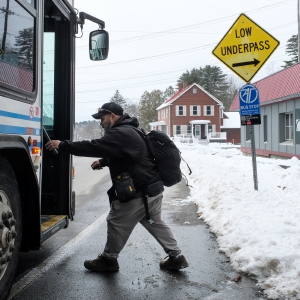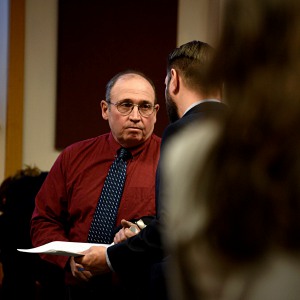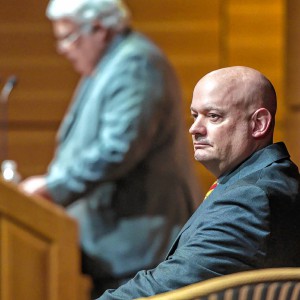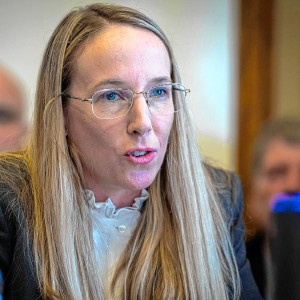Upper Valley schools use federal pandemic money to create new learning programs
| Published: 01-08-2023 6:56 AM |
WEST LEBANON — Twin State educators say they are unsurprised by the National Assessment of Educational Progress scores released in the fall, which showed declines in reading and math scores between 2019 and 2021, before and amid the COVID-19 pandemic.
The results released nationally in late October include reading and math scores for fourth and eighth graders. Nationally and in each of the Twin States, across both subjects and grades tested, average scores declined from 2019 to 2021. New Hampshire’s scores were above the national average in all four categories, while Vermont was above average in eighth grade and slightly below in fourth.
“I don’t think there’s anyone out there who thought there wouldn’t be a decline,” Randy Gawel, superintendent of the Orange East Supervisory Union, said, noting that students usually backslide over the course of the summer and these latest scores reflect “two years of disruption.”
At the same time, schools have received Elementary and Secondary School Emergency Relief, or ESSER, money through three separate federal pandemic relief acts. The money, which the state agencies of education are required to distribute largely based on the share of Title 1 funds schools receive, which are provided to schools with high rates of children from low-income families, was intended to help schools respond to the COVID-19 pandemic, including preventing and addressing learning loss.
Upper Valley schools received varying amounts of relief and have used it in different ways, from tutoring to creating a new kindergarten classroom, from supporting students’ mental and emotional health to investing in new curricula and professional development. In some cases it’s too soon to tell whether and how the efforts might be helping students recover learning they might have lost due to pandemic disruptions, but school leaders largely say that they think students will recover.
“I think they can come back from it,” said Christine Bourne, interim superintendent of the Windsor Southeast Supervisory Union. “I think it’s really making sure that in your system you have a clear vision.”
The $4.05 million that Windsor Southeast has been allocated through ESSER funds has gone in part to mental health support, which Bourne said is necessary to ensure that students are ready to absorb their lessons.
“That’s part of this recovery kids have to be able to learn,” she said. “They have to feel safe. They have to be fed. Their mental health and emotional needs have to be met.”
Article continues after...
Yesterday's Most Read Articles
 Upper Valley winter shelters kept dozens warm and dry
Upper Valley winter shelters kept dozens warm and dry
 Former principal of South Royalton School released from prison
Former principal of South Royalton School released from prison
 Owner of Friesian horse facility ordered to pay care costs for seized animals
Owner of Friesian horse facility ordered to pay care costs for seized animals
WSESU also has used ESSER funds to reduce class sizes by hiring more teachers and hiring interventionists to support children who are struggling in reading and math. It has used some money to operate a summer academy program for the entire supervisory union the past two summers and to operate a transitional kindergarten in Hartland that uses a play-based program but still addresses kindergarten standards and is open to young 5-year-olds and 5-year-olds who didn’t have the opportunity to attend preschool. Afterward, students can move on to a typical kindergarten or to first grade.
“It’s been really, really successful,” Bourne said, adding that she hopes it will continue after the ESSER funds run out. “We did the best we could in the moment with what we knew.”
Like the WSESU, Grantham has used some of its $233,843 in ESSER funds to support students’ mental health. Grantham has hired part-time social worker and mental health counselor to meet with students as needed, Superintendent Sydney Leggett said. Students are identified by the school counselor, teachers or families.
In addition, some of Grantham’s funds went to a literacy program and for facilities, to pay for tents when the school tried to keep students outside earlier in the pandemic.
“We just looked at our recent scores in the fall,” Leggett said. The school gained in math and science, but was down one percentage point in literacy.
“Overall we’re seeing that we fared well in terms of learning loss,” she said.
The Hartford School District has devoted a portion of its $3.9 million in ESSER funds to supporting students’ mental health, according to a chart provided by Superintendent Tom DeBalsi. This school year, the money is supporting one mental health clinician, one student assistance professional and five behavioral interventionists.
“I would say everything we have done has addressed learning loss,” DeBalsi said. “Clinical staff, including behavior interventionists, have provided the critical scaffolding that is necessary for students to access their learning.”
In the Orange East Supervisory Union, which includes Bradford, Vt.-area schools, Gawel said ESSER funds, which total $10.2 million, have been used to fund support staff to help kids social emotionally, as well as for learning coaches, and math and reading interventionists.
“All of these things are an effort to make the process back to something akin to normalcy easier,” Gawel said.
And Gawel said that test scores aren’t necessarily the right measurement of how schools are serving their students.
“The bottom line is we have a lot of really caring adults working with great kids, great families,” he said. “There are just good people who care about one another who are working together to make things better.”
Other educators say that academic performance was sliding prior to the pandemic and the slide has simply continued. To address those longer-standing challenges, some school officials, including those in the Windsor Central Supervisory Union, are looking to shake up their curricula. To do that, however, they need substitutes, who are currently in short supply, so teachers can have the time they need for professional development.
Sherry Sousa, Windsor Central’s superintendent, said her supervisory union, which includes Woodstock-area schools, has used some of its ESSER funds, which total $4.2 million, to train teachers in literacy and math practices.
“What we’ve been doing needs to be reconsidered,” Sousa said. Her supervisory union is “not content with (where) scores are” and “teachers are saying we need to do this work.”
The ESSER funds have helped to purchase the curricula and materials necessary for this push. But it has been more challenging for teachers to find the time they need to learn the theories behind the new methods of instruction. It takes nine full days for the new literacy curriculum, Sousa said.
“We really want to interrupt the predictability of success,” Sousa said. “Students come in reading, and guess what? They leave reading.”
If the schools are able to bring up their test scores, Sousa said she’s hopeful that they will be more attractive for families, including some in neighboring communities that allow tuitioning.
Hartford also has spent some of its ESSER money on a new literacy curriculum and associated professional development, according to materials provided by DeBalsi. This year, Hartford is using ESSER money to fund 2.5 pre-K teaching positions, as well two interventionists and one instructional coach, and an English as a second language teacher. It also has used the federal funds for summer programs, tutoring and after school programs.
“Instructional coaches have supported teacher pedagogy and continued development of their practice,” DeBalsi said. “Outdoor education and after-school initiatives have provided high-interest, physical activities necessary for students to stay engaged and interested in their learning.”
Cornish is using its $269,138 in ESSER funding toward facilities projects aimed at improving the overall health and safety of the building, said Leggett, who in addition to being Grantham’s superintendent also is serving as interim superintendent of schools in Plainfield and Cornish. Cornish also will be using ESSER money to focus on math programming, instruction and professional development.
Meanwhile, Plainfield is using its $156,807 in ESSER funds to boost its efforts to meet the needs of all learners, Leggett said. Initially, this included access to technology, training and staff to support modifications to curriculum and instruction. More recently, ESSER money used to add technology, software, training and staff to better identify and provide targeted support to struggling students.
Some of Lebanon’s $3.7 million in ESSER funds has gone to pilot math programs and to purchase math materials for the 2023-24 school year, according to Superintendent Joanne Roberts. Lebanon currently uses the enVisions math program. At the end of last year, Lebanon’s math teachers met and developed a rubric to select a new math program. Some teachers are piloting new programs now and a decision will be made this spring.
“Lebanon has done very well on state assessments compared to other schools in the state, and we want to make sure that any math framework selected is research- and standards-based,” Roberts said. “It should provide a common math language, scaffolding, clearly articulated learning objectives and meaningful assessment tools. Our teachers have put a lot of time into developing a districtwide math curriculum, and I am certain they will select a program that will meet the needs of our teachers and students.”
In addition, Lebanon has devoted some of the pandemic relief money to the $5.5 million renovation of the Mount Lebanon School and also to its work on diversity and equity, Roberts said.
Mascoma Valley Regional School District has devoted a chunk of its $3.24 million in ESSER funds to an interventionist position and to after-school tutoring, Superintendent Amanda Isabelle said. Parents and teachers can request that students participate in the tutoring, which is provided by the district’s teachers.
As soon as educators began to worry about learning loss early in the pandemic, Isabelle said, the district looked at data to “figure out where are the gaps for these kids and how do we best close the gaps?”
The interventionist supported by ESSER money was the one tasked with much of that data work, which involves using information gathered through Aimsweb, a progress monitoring system, Isabelle said.
The tutoring program is flexible so that some students come in regularly, while others might just come in for additional help with a specific unit such as adding fractions.
“Sometimes it’s the boost that kids need,” Isabelle said.
While Mascoma has put in a lot of work to address learning loss, Isabelle said she doesn’t think that most Upper Valley schools were as affected by pandemic-related closures or at-home learning as those in other parts of the country.
“We worked very, very hard to keep schools open and keep kids in class,” she said.
Nora Doyle-Burr can be reached at ndoyleburr@vnews.com or 603-727-3213.

 Over Easy: ‘A breakfast without a newspaper is a horse without a saddle’
Over Easy: ‘A breakfast without a newspaper is a horse without a saddle’ Lawsuit accuses Norwich University, former president of creating hostile environment, sex-based discrimination
Lawsuit accuses Norwich University, former president of creating hostile environment, sex-based discrimination In divided decision, Senate committee votes to recommend Zoie Saunders as education secretary
In divided decision, Senate committee votes to recommend Zoie Saunders as education secretary
